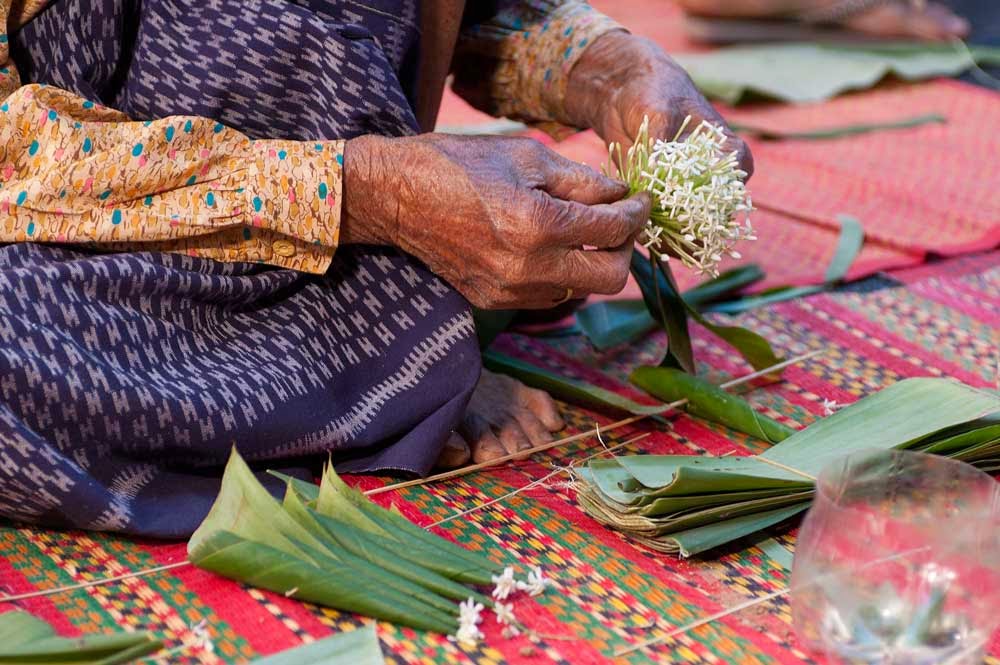 |
| Pha Kwan (Pah kwan) Used In "Marriage" Ritual |
I have written that I do not necessarily believe everything that I learn and experience in my life here in Southeast Asia but then again that is also true of my life back in the USA - perhaps even more so because language is not such an issue for me over there. However I strive to be truthful and accurate in what I have observed and experienced here. I leave it to the reader to come to their own conclusions based upon the facts that I have shared.
Last week I witnessed the preparations for the Bone Party of a villager in Tahsang Village, my wife's home village. A big part of the preparations, along with preparing food, making offerings for the upcoming ritual, and building basahts, was making the banana leaf and flower centerpiece for the ritual. For a long time I have referred to this arrangement as "bai sii su kwan" or "pahn sii khawn". I did not make it up, this is what I was told by my wife or at least what I heard her tell me.
Duang is ethnic Lao - a heritage and culture more in line with the people who live along the lowlands of the Mekong River in Lao than the majority of Thai people. The people here speak "Isan" - actually Lao amongst themselves and speak Thai when dealing with government and "high class" people. As such Duang knows two words, sometimes very different words, for everything. Two words that she has to translate into English for me to understand. Take for instance - Jack Fruit, one of my favorite fruits. In Lao it is, or what sounds like to me - "Buck mee" but in Thai it is or once again sounds like to me - "koh num". I have mentioned a couple of times, "or what sounds like to me", this is of great importance especially in being able to write an Anglicized version of the word. But it is extremely difficult here - Isan has six tonal variations for saying words. The way you say a word completely changes its meaning - talk about apples and oranges! Thai is also a tonal language but has ONLY five ways of saying a word. This complicates communication at times - all the time when you can only distinguish three of the tones most of the time.
 |
| Two pha kwan for Bai Sii related to casting Buddha statue |
Well I now learn that what I had been calling "bai sii su kwan" or "pahn sii khawn" is actually "pah kwan" or/and "pha kwan".
Pha kwan is an ornate floral arrangement consisting of banana leaves, ornate pressed metal bowls either silver or gold colored (gold is typically used for more auspicious ceremonies), flower buds, flowers, and pieces of cotton string.
Pha kwan are the centerpiece(s) of an ancient ritual of the Lao peoples (including their cousins now living in Isaan (Isan, Esan, Esarn, Isarn). The ancient ritual, Bai Sii (Baci, Su Kwan or in the case of my wife - "Bai Sii Su Kwan") harkens back to the time when Animism was the religious belief system of the land - in the time before Brahmanism, Hinduism, and eventually Buddhism arrived.
Bai Sii (baci) rituals dominate life here in Isaan even today. Bai Sii rituals are conducted to mark significant events in an individual's life or community events. Bai Siis are performed for marriages, prior to the ordination of a novice Monk, birth of a child, a Bone Party, to heal or cure, to celebrate recovery from illness, to wish good luck before a grand journey, to honor visitors, and to celebrate a success.
It is believed, still today, that there are 32 spirits that inhabit the body. These spirits are necessary to maintain health, wealth, and fortune. Sometimes some of the spirits will wander off which creates problem for the individual. A bai sii ritual is conducted to call back the wandering spirits and to ensure that they remain in place by wrapping around and tying the right wrist of the person with short pieces of cotton string - sai sin.
 |
| Elderly Female Villagers Making Pha Kwan Components |
 |
| Assembling a Pha Kwan |
The other elderly women associated with making the pha kwan were occupied with making smaller cones, placing flower buds at the tips and stringing them together.
 |
| Duang's Aunt At Work |
The strings of small banana leaf cones will be shaped to form wing like shapes attached to the central cone of the pha kwan.
 |
| Soaking Wing Like Structures To Keep Them Fresh |
 |
| Attaching the Wing Like Structures to Central Cone |
 |
| Plucking Buds To Attach to Banana Leaf Cones |
The baci ritual is intended to benefit an individual - either living or dead. However, as often in the case here, it is not what it first seems to be . Besides benefiting the individual, the baci ritual also benefits the family and community by strengthening their bonds - just as the bonds of the sai sin contain the recalled spirits of the individual. Harmony of the community as well as within the individual is a highly respected and a desired state for the ethnic Lao of Lao and Northeast Thailand.









No comments:
Post a Comment